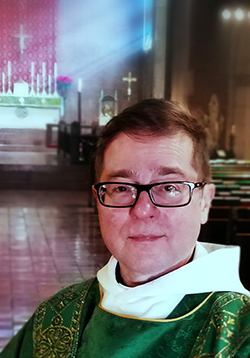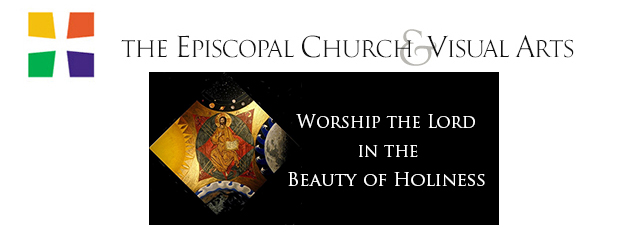|
 Worship of God takes many forms. Much is verbal, but the words of worship are often accompanied by a humble sense of their inadequacy to comprehend the incomprehensible greatness of God. Saint Gregory the Great taught that images offer a path to understanding for those unskilled in words — and when it comes to the quest of faith seeking understanding of God, we are all ultimately unskilled. Worship of God takes many forms. Much is verbal, but the words of worship are often accompanied by a humble sense of their inadequacy to comprehend the incomprehensible greatness of God. Saint Gregory the Great taught that images offer a path to understanding for those unskilled in words — and when it comes to the quest of faith seeking understanding of God, we are all ultimately unskilled.
So it is that the verbal and the visual serve side by side, each mode fulfilling the goals best suited to the minds and hearts of those who worship. In this exhibit, visual artists have found ways to “incarnate” their visions in dialogue with the texts from the Book of Common Prayer, the Bible, and the Hymnal — as a visual “Museum of Common Prayer” to accompany those venerable words: the beauty of holiness mirrored in the holiness of beauty, the union of the Good, the True, and the Beautiful as a pointer towards the ineffable and inexpressible that is beyond our grasp — but as close as every breath we take.
This virtual Museum consists of five Galleries, each with seven images.
The theme of the first is Nature, the setting in which the first intimations of worship arose in the hearts of our ancient ancestors. The primal chaos of the starry heavens in Hazel Bartram-Birchenough's "Transfiguration," suggests the cosmic vision of Eucharistic Prayer C; but the gallery begins with the dry forest of Elizabeth de Sherbinin’s “Barren but Full” — dry, but expecting the rains promised by Catherine Quehl-Engel’s “Rest a While” and “Morning Prayer,” and fulfilled, in all their baptismal glory, by Claudia Smith’s “Legacy” and “Promised Spring” to bloom into a radiant bouquet in Marilyn Witt’s “Summer's End.”
Gallery Two introduces the theme of Incarnation, beginning with the reminder of Christ in eternal splendor (Mary Jane Miller’s “Christ Enthroned”) but then portraying the sacred sequence of Annunciation (Amy Bright Unfried), Incarnation (David Orth’s “Descent”), and birth (Janita Lo’s “Theotokos”). There can never be an end of memorial praise for the one to be hymned by every generation, so a threefold Magnificat rings this gallery to a close with more images of the Madonna from Caroline Furlong, Chuck Kirchner, and Alisa Clark.
Gallery Three brings us to the Church, itself prefigured in the Blessed Virgin, but here pictured in less fleshly architecture, beginning and ending with the Gothic forms of Joyce Beaulieu’s “Vaults of Norwich” and Catherine Gibbs’s “Sanctuary.” The little church building in Melissa Strickler’s “Psalm 141” seems to dance with joy as it connects with the source of its life above, living out its promise “on earth as it is in heaven.” Windows and towers feature in the work of Jerry Di Falco and Bill Livingston, and Mary Jane Miller reminds us of the ancient image of the church as ark of salvation, still dimly remembered when we call our worship spaces “naves.” And before we pass through the exit arch, Jeanelle McCall’s “Renewed” reminds us of how the church is made up of the many become one, like the varied fabrics and materials of a quilt, made into something new and unexpected.
Gallery Four, Sacraments, reminds us of what happens in and through the church, the coming to be of Sacraments. Carol Ann Webb’s “Maundy Thursday Silence” invites us to a moment of quiet within the sacred space, as four images of the Eucharistic feast from four different artists frame Elana Foundos’s 3-D construction, “Of the Holy Cross.” Finally, Gary Gorby’s “Communion with the Saints” with the Holy Table set for sacrament invites us to recall those still outside looking in. Do they hear, as they stand in the cold, voices that remind them of home, and of who, and whose, they are? Will they come in? Will we go out to them?
Gallery Five seeks to answer that question in the theme of Mission, a dismissal beginning and ending with RaRa Schlitt’s reminders that God is not only found in the church building, and that saints are met in lanes, and in shops, and at tea — or in this case “Coffee.” There are unknown saints waiting for a word as they bask in the silent radiance that streams from the fountain of life in Kathy Bozzuti-Jones’s “Still Life with Radiance, NYC.” Chuck Kirchner’s “After He Had Supped” reminds us that the disciples left the upper room once the Sacrament had been consumed, and it was time to face another chapter in the sacred story, but Gethsemane and Calvary lay ahead. In all of these, the Christ is never completely alone, even though his companions are sometimes sleeping; he is surrounded by saints (Zachary Roesemann’s “Holy Cross Triptych”) and angels (Jack Pachuta’s “Christ in Majesty”) but those angels sometimes take unexpected forms, as in Bozzuti-Jones’s “Angels of Utica Avenue” — and how often have they, or Christ himself, been amongst us, and we all unaware? Who is that lonely newcomer at the Coffee Hour?
It is the church's task to raise our awareness, and to direct us Godward. I pray these images may have helped in some small way so to do.
-- Tobias Stanislas Haller BSG, Curator
Bio: Tobias Stanislas Haller BSG retired after 16 years as Vicar at St James Fordham (Bronx NY). While in New York he served in diocesan leadership, at General Convention, and on the Anglican Communion Indaba Reference Group. Now living in Baltimore, he continues to supply and is an associate at Church of the Advent. He is a member of the Brotherhood of Saint Gregory, and a Commander of the Order of St John. He is an iconographer, visual artist, and musician. His publications include The Episcopal Handbook Revised (Church Publishing 2015) and Preparing for a Wedding in the Episcopal Church (Church Publishing 2017). Re-membering God: Human Hope and Divine Desire, also from Church Publishing, appears this spring; it includes chapters on liturgy, art, music, and architecture as human articulations of the Godward quest.
|


 Worship of God takes many forms. Much is verbal, but the words of worship are often accompanied by a humble sense of their inadequacy to comprehend the incomprehensible greatness of God. Saint Gregory the Great taught that images offer a path to understanding for those unskilled in words — and when it comes to the quest of faith seeking understanding of God, we are all ultimately unskilled.
Worship of God takes many forms. Much is verbal, but the words of worship are often accompanied by a humble sense of their inadequacy to comprehend the incomprehensible greatness of God. Saint Gregory the Great taught that images offer a path to understanding for those unskilled in words — and when it comes to the quest of faith seeking understanding of God, we are all ultimately unskilled.